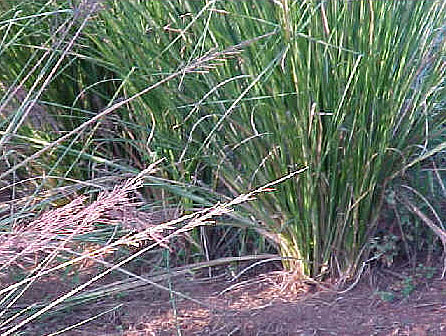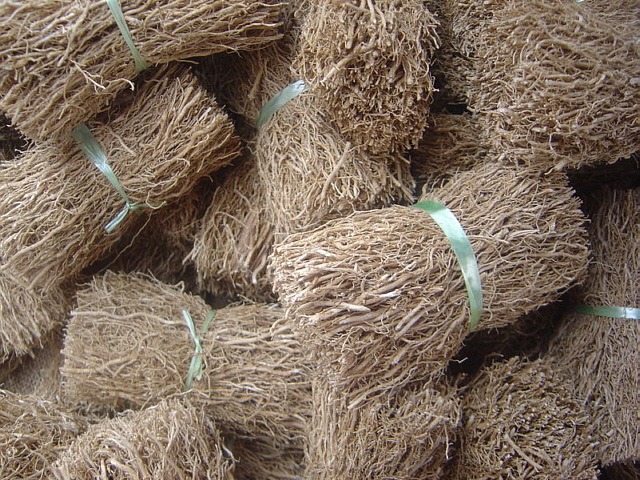

Zitierweise / cite as:
Carakasaṃhitā: Ausgewählte Texte aus der Carakasaṃhitā / übersetzt und erläutert von Alois Payer <1944 - >. -- Anhang A: Pflanzenbeschreibungen. -- Vetiveria zizanoides (L.) Nash -- Fassung vom 2007-06-27. -- URL: http://www.payer.de/ayurveda/pflanzen/vetiveria_zizanoides.htm
Erstmals publiziert: 2007-06-27
Überarbeitungen:
Anlass: Lehrveranstaltung SS 2007
©opyright: Dieser Text steht der Allgemeinheit zur Verfügung. Eine Verwertung in Publikationen, die über übliche Zitate hinausgeht, bedarf der ausdrücklichen Genehmigung des Verfassers
Dieser Text ist Teil der Abteilung Sanskrit von Tüpfli's Global Village Library
WARNUNG: dies ist der Versuch einer
Übersetzung und Interpretation eines altindischen Textes. Es ist keine
medizinische Anleitung. Vor dem Gebrauch aller hier genannten Heilmittel wird
darum ausdrücklich gewarnt. Nur ein erfahrener, gut ausgebildeter ayurvedischer
Arzt kann Verschreibungen und Behandlungen machen!
Falls Sie die diakritischen Zeichen nicht dargestellt bekommen, installieren Sie eine Schrift mit Diakritika wie z.B. Tahoma.
Verwendete und zitierte Werke siehe: http://www.payer.de/ayurveda/caraka0001.htm

Abb.: Vetiveria zizanoides
(L.)
Nash — Vetivergras
[Bildquelle: Wikipedia]

Abb.: Vetiver-Bündel auf einem Markt
[Bildquelle: Wikipedia]
Drury:
Andropogon muricatum (Retz). Do.
- Cuscus-grass, Eng.
- Balah, Hind. and Duk.
- Vetti-ver, Vizhal-ver, Ilamich-cham-ver, Viranam, Tam.
- Vatti-veru, Awuru-gaddiveru, Vidavali-veru, Ouru-vern, Tel.
- Vetti-ver, Ramach-cham-ver, Mal.
- Bala, Shandaler-jar, Beng.
Description.—Root perennial, fibrous; culms numerous, smooth, slightly compressed at the base, 4-6 feet; leaves bifarious near the base, narrow, erect; florets in pairs, awnless, male and hermaphrodite, the former pedicelled, latter sessile.—Roxb. Flor. Ind. i. 265.—Anatherum muricatum, Beauv.— Phalaris Zizania, Linn.-------Bengal. Peninsula.
Medical Uses.—An infusion of the root is used as a gentle stimulant, and makes a grateful drink in fevers. Reduced to powder, the roots are employed in bilious affections; and, mixed with milk, are used externally as cooling applications to skin irritations. Antispasmodic, diaphoretic, diuretic, and emmonagogue properties have been assigned to this grass, but it is not reckoned a valuable medicine.—Ainslie. Pereira. Pharm. of India.
Economic Uses.—The roots are made into fans, and being thinly worked into bamboo frames, are employed for the purpose of cooling the heated atmosphere in dwelling-houses during the hot winds. These are known as the Cuscus tatties. The grass is used, for thatching bungalows and for covering palanquins.—Roxb."
[Quelle: Drury, Heber <1819 - 1872>: The useful plants of India : with notices of their chief value in commerce, medicine, and the arts. -- 2d ed. with additions and corrections. London : Allen, 1873. -- xvi, 512 p. ; 22 cm. -- s.v.]
Dutt:
"ANDROPOGON MURICATUS, Retz. Sans. Usira, Virana,
Vem. Benā, Beng. Khas, Hind,
The root of this plant is well known as the khas khas root of which talis or door screens are made for watering during the hot weather, It is described as cooling, refrigerant, stomachic and useful in pyrexia, thirst, inflammation, irritability of stomach, etc. It enters into the composition of several cooling medicines, as for example, the preparation called Shadanga pāniya, (see Cyperus rotundus ). A weak infusion of the root is sometimes used as a febrifuge drink.
Externally it is used in a variety of ways. A paste of the root is rubbed on the skin to relieve oppressive heat or burning of the body. This use of the drug appears to have been popular with the ancients. Kālidāsa in his drama called Sakuntalā alludes to it as will appear from the passage quoted below. An aromatic cooling bath is prepared by adding to a tub of water the following substances in fine powder, namely, root of Andropogon muricatus, Pavonia odorata ( balā ), red sandal wood, and a fragrant wood called padma kāshtha. The same medicines are reduced to a thin emulsion with water and applied to the skin.
ANDROPOGON SCHOENANTHUS, Linn, Sans, Bhustrina, Vern. Gandha benā, Beng.
ANDROPOGON IWARANCUSA, Roxb. Sans- Lāmajjaka. Vern. Lāmjak, Hind. Karankusā, Beng.
These two fragrant grasses are occasionally used as aromatics and refrigerants like the roots of Andropogon muricatus. A. schoenanthus is common in Bengal, being cultivated in gardens for the sake of its fragrant leaves. A. Iwarancusa is "a native of the skirts of the Northern mountains of India." Its virtues seem to reside in the larger roots marked with annular cicatrices."
[Quelle: Dutt, Uday Chand: The materia medica of the Hindus / Uday Chand Dutt. With a glossary of Indian plants by George King. -- 2. ed. with additions and alterations / by Binod Lall Sen & Ashutosh Sen. -- Calcutta, 1900. - XVIII, 356 S. -- S. 270f.]